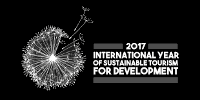COP15: A Global Commitment to Protect Nature
/On Monday 19th December, 2022, a global agreement on nature was reached by almost 200 countries at the UN biodiversity summit, COP15, in Montreal, Canada. It’s being called a ‘Paris Agreement for nature’, after the historic UN treaty on climate change agreed in 2015. But what was agreed and what does it mean, including for tourism?
The Covid pandemic has heightened understanding that the climate and biodiversity crises are intertwined and must be addressed in tandem to avoid trade-offs (eg. promoting nature-based solutions to climate change that harm biodiversity) and increase synergies such as driving relatively more abundant climate finance towards ecological restoration projects to enhance both climate resilience and biodiversity.
Like 2021’s Climate COP27, Biodiversity COP15 is a vital opportunity for developing a coherent global policy framework, approach and targets.
What was agreed at COP15?
It’s a global commitment to halt and reverse biodiversity loss by 2030 and to protect 30% of land and oceans by the same date with an historic package of measures deemed critical to addressing the dangerous loss of biodiversity and restoring natural ecosystems.
COP15 (the 15th Conference of Parties to the UN Convention on Biological Diversity) included representatives of 188 governments on site (95% of all 196 Parties to the UN CBD, as well as two non-Parties – the United States and The Vatican), who finalized and approved this agreement called the “Kunming-Montreal Global Biodiversity Framework” (GBF).
In addition to the GBF, the meeting approved a series of related agreements on its implementation, including on resource mobilization; helping nations to build their capacity to meet the obligations; and digital sequence information on genetic resources.
There is also agreement on planning, monitoring, reporting and review: a comprehensive, science-based monitoring framework commits countries to integrate the GBF goals and targets in their National Biodiversity Strategies and Action Plans (NBSAPs), and by committing them to monitor and report every five years or less on a large set of "headline" and other indicators related to progress against targets in a transparent and comparable manner. Headline indicators include the percent of land and seas effective conserved, the number of companies disclosing their impacts and dependencies on biodiversity, amongst others.
Emphasized throughout the approved documents are the needs to foster the full and effective contributions of women, persons of diverse gender identities, youth, indigenous peoples and local communities, civil society organizations, the private and financial sectors, and stakeholders from all other sectors.
Also emphasized was the need for a “whole-of-government and whole-of-society approach” to implementing the Global Biodiversity Framework’s 4 goals and 23 targets for 2030.
The COP15 Framework’s 4 Global Goals
GOAL A considers biodiversity:
The integrity, connectivity and resilience of all ecosystems are maintained, enhanced, or restored, substantially increasing the area of natural ecosystems by 2050;
Human induced extinction of known threatened species is halted, and, by 2050, extinction rate and risk of all species are reduced tenfold, and the abundance of native wild species is increased to healthy and resilient levels;
The genetic diversity within populations of wild and domesticated species is maintained, safeguarding their adaptive potential.
GOAL B considers biodiversity use by humans:
Biodiversity is sustainably used and managed and nature’s contributions to people, including ecosystem functions and services, are valued, maintained and enhanced, with those currently in decline being restored, supporting the achievement of sustainable development, for the benefit of present and future generations by 2050.
GOAL C considers biodiversity genetic sequence information:
The monetary and non-monetary benefits from the utilization of genetic resources, and digital sequence information on genetic resources, and of traditional knowledge associated with genetic resources, as applicable, are shared fairly and equitably, including, as appropriate with indigenous peoples and local communities, and substantially increased by 2050, while ensuring traditional knowledge associated with genetic resources is appropriately protected, thereby contributing to the conservation and sustainable use of biodiversity, in accordance with internationally agreed access and benefit-sharing instruments.
GOAL D considers biodiversity support resourcing:
Adequate means of implementation, including financial resources, capacity-building, technical and scientific cooperation, and access to and transfer of technology to fully implement the Kunming-Montreal global biodiversity framework are secured and equitably accessible to all Parties, especially developing countries, in particular the least developed countries and small island developing States, as well as countries with economies in transition, progressively closing the biodiversity finance gap of $700 billion per year,and aligning financial flows with the Kunming-Montreal Global Biodiversity Framework and the 2050 Vision for Biodiversity.
Kunming-Montreal Global Biodiversity Framework: 23 Targets
Target 1
Ensure that all areas are under participatory integrated biodiversity inclusive spatial planning and/or effective management processes addressing land and sea use change, to bring the loss of areas of high biodiversity importance, including ecosystems of high ecological integrity, close to zero by 2030, while respecting the rights of indigenous peoples and local communities.
Target 2
Ensure that by 2030 at least 30 per cent of areas of degraded terrestrial, inland water, and coastal and marine ecosystems are under effective restoration, in order to enhance biodiversity and ecosystem functions and services, ecological integrity and connectivity.
Target 3
Ensure and enable that by 2030 at least 30 per cent of terrestrial, inland water,and coastal and marine areas, especially areas of particular importance for biodiversity and ecosystem functions and services, are effectively conserved and managed through ecologically representative, well-connected and equitably governed systems of protected areas and other effective area-based conservation measures, recognizing indigenous and traditional territories, where applicable,and integrated into wider landscapes, seascapes and the ocean, while ensuring that any sustainable use, where appropriate in such areas, is fully consistent with conservation outcomes, recognizing and respecting the rights of indigenous peoples and local communities including over their traditional territories.
Target 4
Ensure urgent management actions, to halt human induced extinction of known threatened species and for the recovery and conservation of species, in particular threatened species, to significantly reduce extinction risk, as well as to maintain and restore the genetic diversity within and between populations of native, wild and domesticated species to maintain their adaptive potential, including through in situ and ex situ conservation and sustainable management practices, and effectively manage human-wildlife interactions to minimize human-wildlife conflict for coexistence.
Target 5
Ensure that the use, harvesting and trade of wild species is sustainable, safe and legal, preventing overexploitation, minimizing impacts on non-target species and ecosystems, and reducing the risk of pathogen spill-over, applying the ecosystem approach, while respecting and protecting customary sustainable use by indigenous peoples and local communities.
Target 6
Eliminate, minimize, reduce and or mitigate the impacts of invasive alien species on biodiversity and ecosystem services by identifying and managing pathways of the introduction of alien species, preventing the introduction and establishment of priority invasive alien species, reducing the rates of introduction and establishment of other known or potential invasive alien species by at least 50 percent, by 2030, eradicating or controlling invasive alien species especially in priority sites, such as islands .
Target 7
Reduce pollution risks and the negative impact of pollution from all sources, by2030, to levels that are not harmful to biodiversity and ecosystem functions and services, considering cumulative effects, including: reducing excess nutrients lost to the environment by at least half including through more efficient nutrient cycling and use; reducing the overall risk from pesticides and highly hazardous chemicals by at least half including through integrated pest management, based on science, taking into account food security and livelihoods; and also preventing,reducing, and working towards eliminating plastic pollution.
Target 8
Minimize the impact of climate change and ocean acidification on biodiversity and increase its resilience through mitigation, adaptation, and disaster risk reduction actions, including through nature-based solution and/or ecosystem-based approaches, while minimizing negative and fostering positive impacts of climate action on biodiversity.
Target 9
Ensure that the management and use of wild species are sustainable, thereby providing social, economic and environmental benefits for people, especially those in vulnerable situations and those most dependent on biodiversity, including through sustainable biodiversity-based activities, products and services that enhance biodiversity, and protecting and encouraging customary sustainable use by indigenous peoples and local communities.
Target 10
Ensure that areas under agriculture, aquaculture, fisheries and forestry are managed sustainably, in particular through the sustainable use of biodiversity, including through a substantial increase of the application of biodiversity friendly practices, such as sustainable intensification, agroecological and other innovative approaches contributing to the resilience and long-term efficiency and productivity of these production systems and to food security, conserving and restoring biodiversity and maintaining nature’s contributions to people, including ecosystem functions and services.
Target 11
Restore, maintain and enhance nature’s contributions to people, including ecosystem functions and services, such as regulation of air, water, and climate,soil health, pollination and reduction of disease risk, as well as protection from natural hazards and disasters, through nature-based solutions and ecosystem-based approaches for the benefit of all people and nature.
Target 12
Significantly increase the area and quality and connectivity of, access to, and benefits from green and blue spaces in urban and densely populated areas sustainably, by mainstreaming the conservation and sustainable use of biodiversity, and ensure biodiversity-inclusive urban planning, enhancing native biodiversity, ecological connectivity and integrity, and improving human health and well-being and connection to nature and contributing to inclusive and sustainable urbanization and the provision of ecosystem functions and services.
Target 13
Take effective legal, policy, administrative and capacity-building measures at all levels, as appropriate, to ensure the fair and equitable sharing of benefits that arise from the utilization of genetic resources and from digital sequence information on genetic resources, as well as traditional knowledge associated with genetic resources, and facilitating appropriate access to genetic resources,and by 2030 facilitating a significant increase of the benefits shared, in accordance with applicable international access and benefit-sharing instruments.
Target 14
Ensure the full integration of biodiversity and its multiple values into policies, regulations, planning and development processes, poverty eradication strategies, strategic environmental assessments, environmental impact assessments and, as appropriate, national accounting, within and across all levels of government and across all sectors, in particular those with significant impacts on biodiversity, progressively aligning all relevant public and private activities, fiscal and financial flows with the goals and targets of this framework.
Target 15
Take legal, administrative or policy measures to encourage and enable business,and in particular to ensure that large and transnational companies and financial institutions:
(a) Regularly monitor, assess, and transparently disclose their risks, dependencies and impacts on biodiversity including with requirements for all large as well as transnational companies and financial institutions along their operations, supply and value chains and portfolios;
(b) Provide information needed to consumers to promote sustainable consumption patterns;
(c) Report on compliance with access and benefit-sharing regulations and measures, as applicable;
in order to progressively reduce negative impacts on biodiversity, increase positive impacts, reduce biodiversity-related risks to business and financial institutions, and promote actions to ensure sustainable patterns of production.
Target 16
Ensure that people are encouraged and enabled to make sustainable consumption choices including by establishing supportive policy, legislative or regulatory frameworks, improving education and access to relevant and accurate information and alternatives, and by 2030, reduce the global footprint of consumption in an equitable manner, halve global food waste, significantly reduce overconsumption and substantially reduce waste generation, in order for all people to live well in harmony with Mother Earth.
Target 17
Establish, strengthen capacity for, and implement in all countries in biosafety measures as set out in Article 8(g) of the Convention on Biological Diversity and measures for the handling of biotechnology and distribution of its benefits as set out in Article 19 of the Convention.
Target 18
Identify by 2025, and eliminate, phase out or reform incentives, including subsidies harmful for biodiversity, in a proportionate, just, fair, effective and equitable way, while substantially and progressively reducing them by at least 500 billion United States dollars per year by 2030, starting with the most harmful incentives, and scale up positive incentives for the conservation and sustainable use of biodiversity.
Target 19
Substantially and progressively increase the level of financial resources from all sources, in an effective, timely and easily accessible manner, including domestic, international, public and private resources, in accordance with Article 20 of the Convention, to implement national biodiversity strategies and action plans, by 2030 mobilizing at least 200 billion United States dollars per year, including by:
(a) Increasing total biodiversity related international financial resources from developed countries, including official development assistance, and from countries that voluntarily assume obligations of developed country Parties, to developing countries, in particular the least developed countries and small island developing States, as well as countries with economies in transition, to at least US$ 20 billion per year by 2025, and to at least US$ 30 billion per year by 2030;
(b) Significantly increasing domestic resource mobilization, facilitated by the preparation and implementation of national biodiversity finance plans or similar instruments according to national needs, priorities and circumstances
(c) Leveraging private finance, promoting blended finance, implementing strategies for raising new and additional resources, and encouraging the private sector to invest in biodiversity, including through impact funds and other instruments;
(d) Stimulating innovative schemes such as payment for ecosystem services,green bonds, biodiversity offsets and credits, benefit-sharing mechanisms, with environmental and social safeguards
(e) Optimizing co-benefits and synergies of finance targeting the biodiversity and climate crises,
(f) Enhancing the role of collective actions, including by indigenous peoples and local communities, Mother Earth centric actions and non-market-based approaches including community based natural resource management and civil society cooperation and solidarity aimed at the conservation of biodiversity
(g) Enhancing the effectiveness, efficiency and transparency of resource provision and use;
Target 20
Strengthen capacity-building and development, access to and transfer of technology, and promote development of and access to innovation and technical and scientific cooperation, including through South-South, North-South and triangular cooperation, to meet the needs for effective implementation, particularly in developing countries, fostering joint technology development and joint scientific research programmes for the conservation and sustainable use of biodiversity and strengthening scientific research and monitoring capacities, commensurate with the ambition of the goals and targets of the framework.
Target 21
Ensure that the best available data, information and knowledge, are accessible to decision makers, practitioners and the public to guide effective and equitable governance, integrated and participatory management of biodiversity, and to strengthen communication, awareness-raising, education, monitoring, research and knowledge management and, also in this context, traditional knowledge, innovations, practices and technologies of indigenous peoples and local communities should only be accessed with their free, prior and informed consent, in accordance with national legislation.
Target 22
Ensure the full, equitable, inclusive, effective and gender-responsive representation and participation in decision-making, and access to justice and information related to biodiversity by indigenous peoples and local communities, respecting their cultures and their rights over lands, territories, resources, and traditional knowledge, as well as by women and girls, children and youth, and persons with disabilities and ensure the full protection of environmental human rights defenders.
Target 23
Ensure gender equality in the implementation of the framework through a gender-responsive approach where all women and girls have equal opportunity and capacity to contribute to the three objectives of the Convention, including by recognizing their equal rights and access to land and natural resources and their full, equitable, meaningful and informed participation and leadership at all levels of action, engagement, policy and decision-making related to biodiversity.
Do Questions Remain About the COP15 Agreement?
Yes, some big questions include the definitions of:
“Biodiversity is sustainably used” (Goal B)
“as appropriate” [sharing with indigenous peoples and local communities…] (Goal C)
“Adequate means of implementation…especially developing countries…” (Goal D) - where do they get this from? According to current financial estimates, existing investment needs to at least triple by 2030 and quadruple by 2050 to meet the funding gap for global biodiversity protection.
Finally, this is a voluntary agreement and not legally binding. Will countries adhere? What is the mechanism to monitor and review the implementation of the targets? If countries don’t comply, what can be done?
What Does it Mean for Travel?
Tourism is more often than not based on biodiversity heritage and natural capital. People travel to see different landscapes, species and indigenous and community cultures immersed in local environments. With funding for biodiversity support required, tourism as the engine for sustainable development may be turned to with increasing frequency - and tourism operations increasingly expected to show how they are positive contributing to nature, not exploiting it.
The premise of Earth Changers is focus on positive impact tourism that delivers sustainable development goals benefits locally in destinations for conservation and communities. For COP15’s nature agreement, those directly include SDG14 - life under water, SDG15 - life on land, SDG13 - climate, SDG9 for communities, #SDG12 for responsible consumption, and other ecosystem services supporting life on earth, like SDG6 water, SDG7 energy and, as seen with Covid, the interelation with health SDG3.
Earth Changers and partners prioritise environmental and species protection and run initiatives to support regeneration. For example,
Payment for Ecosystem services eg. to compensate tribes when cattle are killed.
Preventing deforestion & the Maasai’s first REDD+ for Climate Change
Supporting afforestation in the Osa Peninsula, Costa Rica.
Conserving and creating wetlands.
Creating marine protected areas and no take zones.
Responsible whale and dolphin watching.
Ensuring plastic-free tourism to cut pollution including in the oceans.
Creating a beautiful Florilegium to document botanical heritage.
Considering how to value nature.
Keeping bees and understanding the importance of pollinators for tourism.
Challenging the industry on how it uses nature in tourism.
Understanding how we can travel to benefit nature, not damage it.
Offering 5 of the Best Wildlife trips!
















